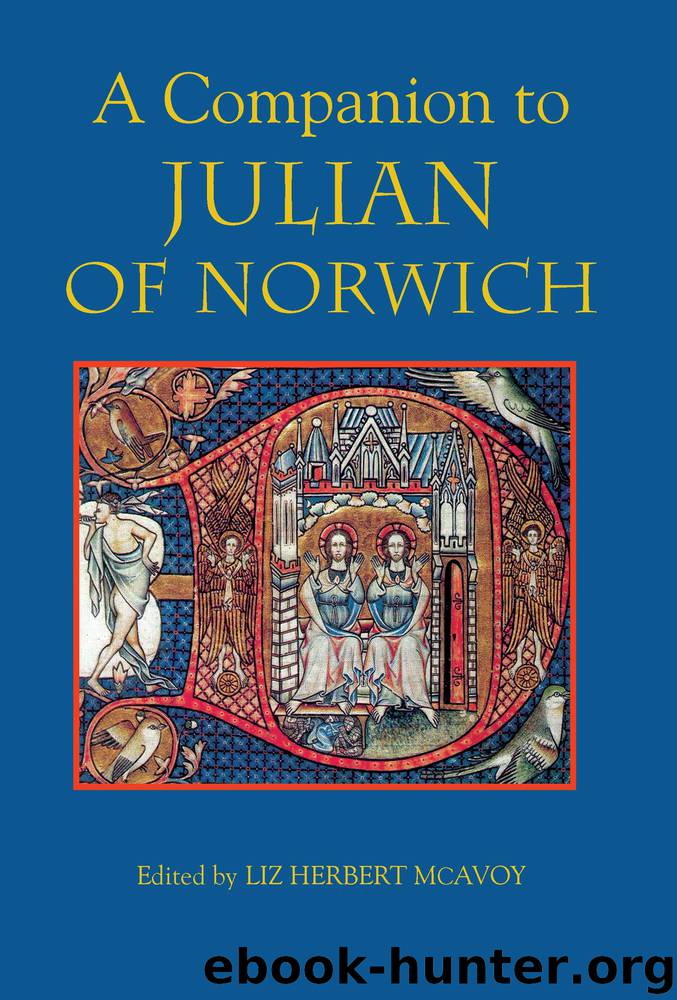A Companion to Julian of Norwich by Liz Herbert McAvoy

Author:Liz Herbert McAvoy
Language: eng
Format: epub
ISBN: 9781782044673
Publisher: Boydell & Brewer Group Ltd
Published: 2015-03-31T04:00:00+00:00
1 See M. Cré, Vernacular Mysticism in the Charterhouse: A Study of London, British Library, MS Additional 37790, The Medieval Translator 9 (Turnhout, 2006).
2 Though the manuscript is owned by Westminster Cathedral, it is on temporary deposit in Westminster Abbey Library. For a description of the manuscript see H. Kempster, ‘The Westminster Text of A Revelation of Love’, Mystics Quarterly 23 (1997), pp. 178–9.
3 See An Exposition of Qui habitat and Bonum est in English, ed. Björn Wallner, Lund Studies in English XXIII (Lund, 1954), pp. xxxix–xliv. References to Qui habitat (QH) and Bonum est (BE) are by page and line numbers and will appear parenthetically in the main text.
4 This suggests that, like Amherst, the compilation was intended to be used in the same circle in which it originated. That none of the fragments in W are attributed to their authors may seem like an indication of the same, yet Hilton’s works are unattributed in most manuscripts, as is Julian’s Long Text.
5 For the place of A Vision in the Amherst anthology see Cré, Vernacular Mysticism, pp. 99–122.
6 See Kempster, ‘The Westminster Text’, and ‘A Question of Audience: The Westminster Text and Fifteenth-Century Reception of Julian of Norwich’, in Julian of Norwich: A Book of Essays, ed. Sandra J. McEntire (New York and London, 1998), pp. 257–89, which only contain minor references to the Hilton texts making up the larger part of the compilation. In Watson and Jenkins’ new edition of Julian of Norwich’s writings, the introduction describes the Revelation fragments as integral to the compilation, but the edition included in Appendix A remains –understandably but regrettably – decontextualized. See The Writings of Julian of Norwich: A Vision Showed to a Devout Woman and A Revelation of Love, ed. Nicholas Watson and Jacqueline Jenkins (Turnhout, 2006), pp. 13–14 and pp. 417–31. References to this edition of the ‘Westminster Revelation’ (WR) are by page number. In the quotations from W, I reproduce the manuscript’s spelling. The compilation as a whole is transcribed and discussed in M. Cré, ‘Westminster Cathedral Treasury MS 4: A Fifteenth-Century Spiritual Compilation’ (unpublished MPhil diss., University of Glasgow, 1997) and ‘Authority and the Compiler in Westminster Cathedral Treasury MS 4: Writing a Text in Someone Else’s Words’, in Authority and Community in the Middle Ages, ed. Donald Mowbray, Rhiannon Purdie and Ian P. Wei (Stroud, 1999), pp. 153–76.
7 This is exactly the activity ascribed to the compilator (as opposed to the scriptor, commentator and auctor) in Bonaventure’s Prologue to his Sentences commentary. The compilator adds together, or arranges the statements of other men, adding no opinion of his own (addendo, sed non de suo). See A. J. Minnis, Medieval Theory of Authorship: Scholastic Literary Attitudes in the Later Middle Ages (London, 1984), p. 94.
8 In focusing on the compiler’s omissions, Kempster inevitably defines the Westminster fragments in terms of loss. Kempster’s comment that ‘it is significant that neither of the two earliest extant copies of [Julian’s] work reproduce [the Long Text’s] unusual integration of mystical prose
Download
This site does not store any files on its server. We only index and link to content provided by other sites. Please contact the content providers to delete copyright contents if any and email us, we'll remove relevant links or contents immediately.
The Gnostic Gospels by Pagels Elaine(2400)
Jesus by Paul Johnson(2230)
Devil, The by Almond Philip C(2207)
The Nativity by Geza Vermes(2117)
The Psychedelic Gospels: The Secret History of Hallucinogens in Christianity by Jerry B. Brown(2073)
Forensics by Val McDermid(1979)
Going Clear: Scientology, Hollywood, and the Prison of Belief by Lawrence Wright(1884)
Going Clear by Lawrence Wright(1873)
Barking to the Choir by Gregory Boyle(1731)
Old Testament History by John H. Sailhamer(1714)
Augustine: Conversions to Confessions by Robin Lane Fox(1688)
The Early Centuries - Byzantium 01 by John Julius Norwich(1655)
A History of the Franks by Gregory of Tours(1639)
The Bible Doesn't Say That by Dr. Joel M. Hoffman(1611)
Dark Mysteries of the Vatican by H. Paul Jeffers(1607)
A Prophet with Honor by William C. Martin(1603)
by Christianity & Islam(1564)
The First Crusade by Thomas Asbridge(1539)
The Amish by Steven M. Nolt(1492)
